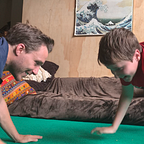3 Steps on how to Deal with Emotional Disruptions
As a Parkour and movement teacher, I’m dealing with emotional disruptions all the time. I thought it might be helpful to all you parents out there if I shared my experience on how to best manage it. Dealing with an emotional disruption can be incredibly difficult, but it doesn’t have to be. I’m going to give you a simple way of how to handle emotional disruptions.
The overarching idea is that you want to connect the emotion to the behavior or the situation that put your kid off track in the first place. The easiest way to do that is by simply asking them “How are you feeling”? Let’s say they are really upset about tying their shoes, because they don’t know how to tie their shoes and they weren’t able to figure it out. Now you connect the emotion to the behavior or situation. They are not upset “just because”, they are upset because they experienced something really frustrating.
Ask them how they are feeling and give them time to respond. Maybe they are not sure how they are feeling. It’s not uncommon for kids and adults to need a moment to actually figure out what and how we are feeling. If they give you a response, you have to make sure you LISTEN to what they are saying. If they don’t give you a response, fill in the blanks with what you perceive to be the case (e.g. “looks like you are upset/frustrated/very excited …”). Check in with them to see how close your guess was. Don’t assume you got it right!
The crucial part is that you listen to them, because if you don’t listen to them, they don’t feel heard (kind of obvious but I wanted to make sure I mention it!). And they need to know that they have room to talk to you, that you are genuinely interested in their response (and not just in what you think is the case). So you listen to their concern and then you validate it. Whatever it is you want to validate their feelings (e.g. “I understand, I get really frustrated when I don’t know how to do something”. “I hate it when I’m upset.” “I love when I get a new present and I get super excited”). It doesn’t matter if you believe the reason that caused that feeling is valid. The feeling they are having is real, you can’t “logic them out” of a feeling. Let them know that you hear them and validate their experience AND their feelings so they know that it’s okay to feel that way.
After validating the situation, you guide them to a better answer: “You are really frustrated because you don’t know how to tie your shoes? Okay. Well, would you like to continue to feel disappointed? No? How about we practice? I’m happy to show you.” or “How about we take a break and try again in a little while?” or what if they’re super excited about something and they’re running around going crazy and you need them to calm down. You can just say: “Hey, it looks like you’re super excited. I can tell, cause you’re going crazy and I bet you want to keep that going. But, we need to manage ourselves. How about we go outside and run around, because in here is not a great place.” Our guidance needs to help them get back on track to the behavior that we want to see from them.
Whatever their behavior is, whether it’s positive or negative, it is always three steps:
- You ask them how they are feeling and listen to their answer.
- You validate the feeling and concern.
- You give them the tools (practice, take a break, go outside and run around, step away and breathe etc.) and guide them to a better answer.
I hope this is helpful. Let us know what you think and if you have any questions you want us to answer!
